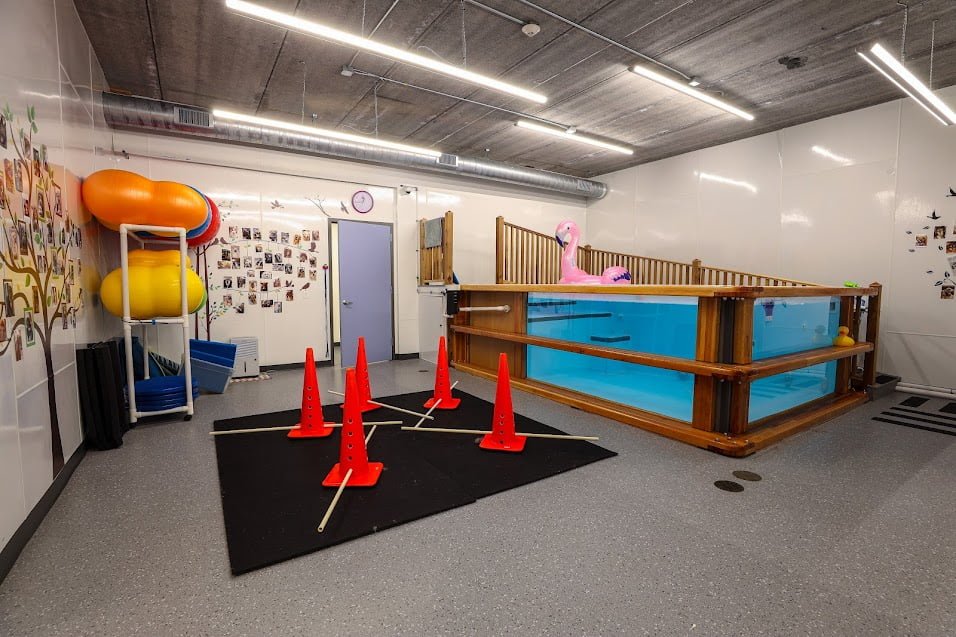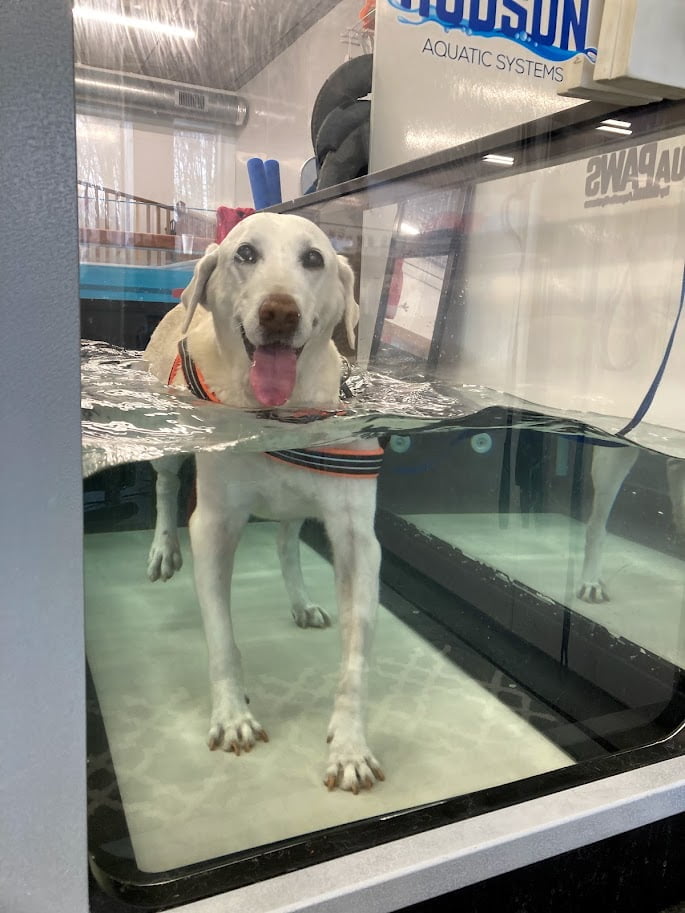Enhancing your Pet’s Mobility and Wellness
If your pet has a medical condition that makes it difficult to carry out everyday activities such as walking, running, or climbing stairs, can rehabilitation really improve their quality of life? The answer is a definite yes!

Like humans, a professionally designed and supervised physical therapy program can help your pet regain optimal function and return to the activities they enjoy most. Whether your pet has been injured, undergone surgery, or is dealing with the effects of aging, veterinary rehabilitation can help improve your pet’s condition. As a pet owner, you receive a comprehensive home exercise program, including detailed instructions, to guide you in assisting your pet in achieving optimal results.

Treatments available for our patients include shockwave, acupuncture, underwater treadmill, swimming, laser and more. We have the only facility in the area with a custom-designed, full-size therapy pool with a ramp for safe, easy access, along with various equipment for land-based exercises.
Conditions we Treat:
Benefits of Treatment:
View this post on Instagram
State-of-the-Art Equipment
Exceptional Services
After a comprehensive initial evaluation, our team will develop a plan of care tailored to your pet’s unique needs. This plan may include:
Electrical Stimulation
Helps with pain relief.
Diagnostics
- Ultrasound of the musculoskeletal system, including the shoulders, triceps, carpus/abductor pollicus longus, calcanean tendon, medial thigh, stifles, and superficial and deep digital flexor tendons.
- Ultrasound-guided injections into the following areas: around the nerves in the neck, shoulders, biceps, elbows, origins of the muscles that flex the forelimbs, carpal joints, sheath around the abductor pollicus longus tendon, sheaths of the superficial and deep digital flexor tendons, metacarpophalangeal and metatarsophalangeal joints, hips, stifles, and tarsi (ankles).
- Sedated CT scans
- X-rays of the hips to screen for hip dysplasia (PennHIP)
- Digital X-rays
- MRI scans
- Blood tests to check for various things, including complete blood count, chemistry panel, thyroid function, and Lyme disease.
- Urinalysis to check for abnormalities in the urine, and urine culture to check for bacteria.
Electroacupuncture
Offeres targeted therapy for issues like musculoskeletal pain, nerve damage, and various chronic conditions.
Extracorporeal Shockwave Therapy
Pulsed sound waves are used to trigger an acute healing response in the cells of the treatment area.
Neuromuscular Electrical Stimulation (NMES)
A therapeutic modality used in veterinary sports medicine to strengthen muscles, improve muscle function, and reduce pain. It is applied by placing electrode pads on the skin over the affected muscle group.
Hydrotherapy
- Underwater treadmill
- Full-size heated pool
Therapeutic Exercise
Used for improving range of motion, strength, coordination, and balance.
Manual Therapy
Massage, stretching, joint and/or soft tissue mobilization
Therapeutic Ultrasound
A non-invasive treatment modality used to promote healing and alleviate pain. This technology utilizes high-frequency sound waves to penetrate tissues deeply, generating heat. This heat, in turn, increases blood flow, relaxes muscles, and can aid in reducing inflammation and promoting tissue repair.
Veterinarians often use therapeutic ultrasound to manage various musculoskeletal conditions, such as tendon injuries, arthritis, and muscle strains. Additionally, it can be beneficial for promoting post-surgical healing and addressing soft tissue injuries.
Measuring and Fitting Assistive Devices
- Wheelchair fittings
- Casting for orthotics
- Adjusting for orthotics
- Help Em Up harness fittings
- Paw friction, toe grips, soft caps, etc. application
Myofascial Release
Involves a hands-on therapy focused on releasing tension and tightness in the fascia, a connective tissue surrounding muscles, bones, and organs in animals. This technique aims to alleviate pain, improve range of motion, and enhance overall mobility by targeting restrictions and adhesions within the fascia.
We use various manual techniques, such as gentle pressure and stretching, to release tight areas in the fascia. By addressing these restrictions, myofascial release can help improve circulation, reduce pain, and enhance the animal’s comfort and flexibility. This therapy is particularly beneficial for animals dealing with musculoskeletal issues, chronic pain, mobility limitations, or recovering from injuries.
Photobiomodulation
Also known as Cold Laser Therapy.
Pulsed Electromagnetic Field Therapy
Used to promote a calm state and influence healing.
Transcutaneous Electrical Nerve Stimulation (TENS)
Manages pain by delivering low-voltage electrical impulses to the skin through electrodes.

Contact Us
If your pet is recovering from an injury, surgery, or chronic condition, we encourage you to schedule a consultation with our rehabilitation team. We can help your pet get back on their feet and enjoy a happy, healthy life. Call us at (914) 704-3400 to get started.





